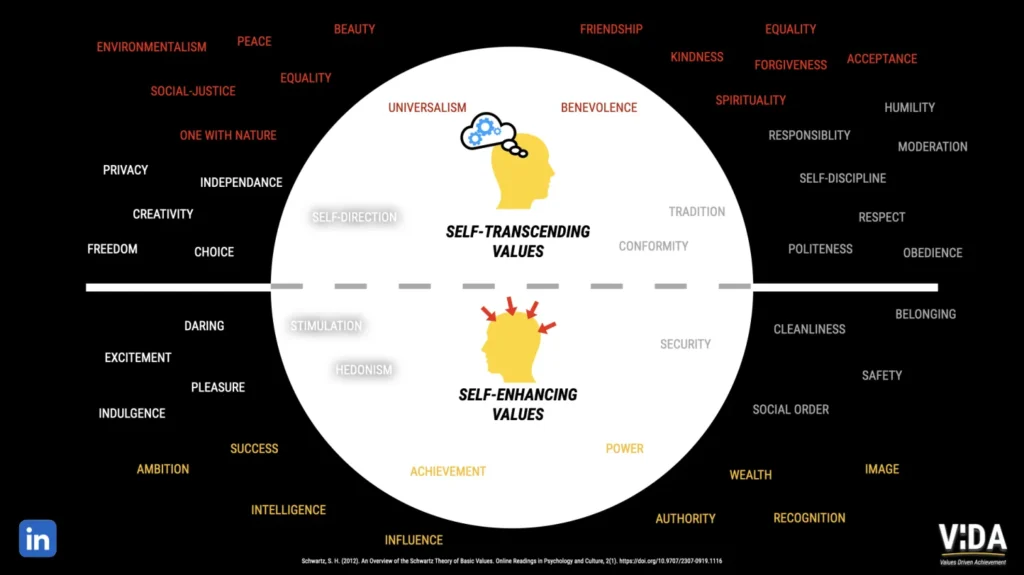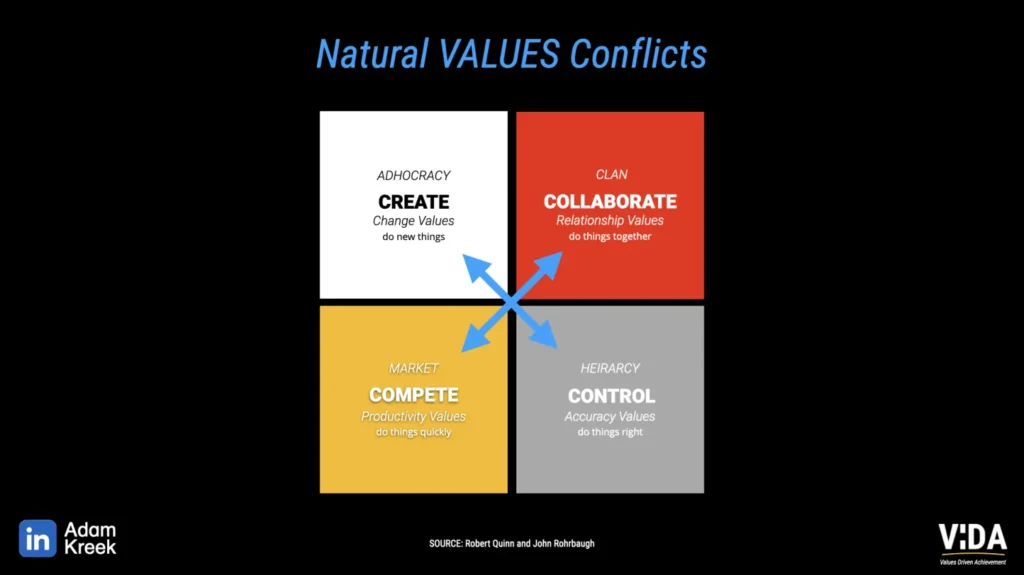
"Don’t let the noise of others’ opinions drown out your own inner voice."
Steve Jobs
Past CEO Apple
- Date
You Can’t Serve Everyone: The Strategic Power of Values Conflict
posted in Values

Adam Kreek
If your values don’t repel some people, they’re probably too vague to matter.
It’s one of the hardest truths for leaders to accept—especially those who are wired for belonging, inclusion, and high performance (like most of us who read or contribute to this blog). We like the idea of shared values. Harmony. Unity. Strength in alignment. And all of that is real—until it isn’t.
Because eventually, your values will bump up against someone else’s.
And that’s not a problem. That’s the point.
Values Will Always Be in Conflict. That’s the System.
Let’s start here: all values are in conflict with something.
They’re supposed to be.
That’s how Schwartz’s theory of basic human values is structured. It’s not a happy rainbow of virtues. It’s a circle of tension and trade-offs.
On one side, you’ll find self-transcendence values: universalism, benevolence, social justice, environmental concern. These are values that elevate others.
On the opposite side of the circle? Self-enhancement values: achievement, power, control, personal success. These are values that elevate the individual.
Neither is “good” or “bad.” Both are necessary. But when one dominates, the other retreats.
You can’t chase achievement and expect to be universally benevolent in every decision. You can’t put power at the centre of your organizational model and not create friction with inclusion. These aren’t bugs in the system. They are the system.
I’ve written before about how these below-the-waterline values (achievement, power, control) are often hidden in the “shadow” of an organization’s brand. But they influence strategy more than most mission statements do.
If you’re trying to build alignment inside a company—or sell to one—you have to understand this.

What About Virtuous Values? Don’t They All Work Together?
Not really.
Even above-the-waterline values—those noble, admirable principles we all want to see in our culture—are in competition.
For example, in the Competing Values Framework, developed by Cameron and Quinn, you’ll see four dominant orientations:
- Collaborate (internal focus + flexibility): values like teamwork, belonging, and participation.
- Create (external focus + flexibility): values like innovation, adaptability, and experimentation.
- Control (internal focus + stability): values like consistency, safety, documentation, precision.
- Compete (external focus + stability): values like performance, results, goal-setting, speed.
Each of these quadrants contains good, respectable values. But they pull in opposing directions.

Try being a marketing firm (create quadrant) that’s selling to an engineering firm (control quadrant). Or a DEI team (collaborate quadrant) trying to shift culture inside a legacy sales org (compete quadrant).
Conflict is baked in.
You can’t smooth-talk your way around this.
Integrate Competing Values for Success
You need to name it. And then decide:
Are we reinforcing this org’s dominant values?
Are we introducing counterweights?
Or are we exposing the shadow values that drive the real behaviour?
Real Clients. Real Clashes.
Let me make this real with a couple of examples pulled from past client work:
1. Control vs. Creativity
An engineering firm hired a marketing agency to revamp their brand and reposition their services for a more innovative market. But the project dragged on. The marketing team kept pushing “fresh thinking” and “outside the box.” The engineers pushed back with concerns about brand integrity, technical accuracy, and legal risk.
Two value sets. Both admirable. Both pulling against each other.
The solution wasn’t “better communication.”
It was values fluency. Naming the difference. Defining the boundaries. And deciding—strategically—where the flexibility would live.
2. Collaboration vs. Competition
A high-performing sales team—targets, bonuses, aggressive growth culture—brought in an HR-led initiative to foster deeper connection, psychological safety, and employee belonging.
Cue the eyerolls.
Why? Because the team’s dominant value wasn’t inclusion. It was performance.
Did that make them wrong? No. But the collaboration message felt like a threat to the very culture that made them successful.
Once we named the values tension, we were able to recast the belonging initiative as a performance enhancer—not a distraction from it.
Strategic Implications: How You Use Values in Sales, Leadership, and Culture
If you’re a consultant, coach, facilitator, or seller, here’s your job:
Understand your own values first.
Then understand the values of the organization you serve.
Then make a choice:
1. Are you reinforcing their values?
If so, you need to prove it.
If they’re a control-focused org, show how your product or service increases precision, reduces variability, and reinforces reliability.
If they’re a compete-driven culture, speak the language of performance, results, and time-to-value.
2. Are you filling in a gap they know they have?
Some organizations will know their values are lopsided. A control-based org might know they lack innovation. A compete-heavy org might know they struggle with talent retention.
In these cases, you position yourself as a complement—not a critique.
3. Are you surfacing shadow values?
This is the trickiest—but also the most transformative—play.
Sometimes, the org says it values inclusion, but operates from achievement and power. Or it says it values creativity, but really values consistency.
Here’s the key: you can’t change this if you don’t name it.
Once it’s named, leaders can make conscious choices.
As I teach in the ViDA course, values are decision fuel, not decorations.
You Can’t Be Everything to Everyone
This is the hard part for leaders. Especially values-driven ones.
You want to believe your values are universally applicable. That your message should land with everyone. That you can serve every team, industry, or department.
But here’s the thing:
Some values will amplify other people’s pain.
Your inclusion will challenge someone’s performance obsession.
Your innovation will threaten someone’s need for control.
Your purpose will activate someone’s shadow.
And that’s not failure. That’s clarity.
It’s what happens when values grow teeth. When they stop being “nice words on the wall” and start driving strategy, hiring, sales, and culture.
Final Thought
You can’t align values unless you understand how they’re wired for conflict.
And you can’t lead (or sell) without choosing sides—intentionally.
So take a clear stance:
- Are you amplifying their dominant values?
- Are you offering balance by representing the opposite pole?
- Or are you courageously calling out the values conflict they won’t name?
Once you decide, everything becomes clearer:
Your positioning. Your offer. Your team. Your impact.
Because values aren’t about being liked.
They’re about making change that lasts.
Author’s Note
For more on the Schwartz theory of values and how they show up in business, read one of these:
And if you’re ready to build a high-performing team grounded in aligned, strategic values? Let’s talk.
–––––
Adam Kreek and his team are on a mission to positively impact organizational cultures and leaders who make things happen.
He authored the bestselling business book, The Responsibility Ethic: 12 Strategies Exceptional People Use to Do the Work and Make Success Happen.
Want to increase your leadership achievement? Learn more about Kreek’s coaching here.
Want to book a keynote that leaves a lasting impact? Learn more about Kreek’s live event service here.